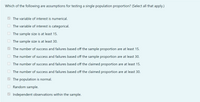hich of the following are assumptions for testing a single population proportion? (Select all that apply.) O The variable of interest is numerical. O The variable of interest is categorical. O The sample size is at least 15. O The sample size is at least 30. O The number of success and failures based off the sample proportion are at least 15. O The number of success and failures based off the sample proportion are at least 30. O The number of success and failures based off the claimed proportion are at least 15. J The number of success and failures based off the claimed proportion are at least 30. O The population is normal. O Random sample. O Independent observations within the sample.
hich of the following are assumptions for testing a single population proportion? (Select all that apply.) O The variable of interest is numerical. O The variable of interest is categorical. O The sample size is at least 15. O The sample size is at least 30. O The number of success and failures based off the sample proportion are at least 15. O The number of success and failures based off the sample proportion are at least 30. O The number of success and failures based off the claimed proportion are at least 15. J The number of success and failures based off the claimed proportion are at least 30. O The population is normal. O Random sample. O Independent observations within the sample.
MATLAB: An Introduction with Applications
6th Edition
ISBN:9781119256830
Author:Amos Gilat
Publisher:Amos Gilat
Chapter1: Starting With Matlab
Section: Chapter Questions
Problem 1P
Related questions
Question

Transcribed Image Text:Which of the following are assumptions for testing a single population proportion? (Select all that apply.)
O The variable of interest is numerical.
O The variable of interest is categorical.
The sample size is at least 15.
The sample size is at least 30.
The number of success and failures based off the sample proportion are at least 15.
The number of success and failures based off the sample proportion are at least 30.
The number of success and failures based off the claimed proportion are at least 15.
O The number of success and failures based off the claimed proportion are at least 30.
O The population is normal.
Random sample.
O Independent observations within the sample.
Expert Solution
This question has been solved!
Explore an expertly crafted, step-by-step solution for a thorough understanding of key concepts.
This is a popular solution!
Trending now
This is a popular solution!
Step by step
Solved in 2 steps

Follow-up Questions
Read through expert solutions to related follow-up questions below.
Follow-up Question
Based on your explanation, I selected the options, however they seem to be wrong

Transcribed Image Text:Which of the following are assumptions for testing a single population proportion? (Select all that apply.)
O The variable of interest is numerical.
The variable of interest is categorical.
O The sample size is at least 15.
The sample size is at least 30.
The number of success and failures based off the sample proportion are at least 15.
The number of success and failures based off the sample proportion are at least 30.
The number of success and failures based off the claimed proportion are at least 15.
The number of success and failures based off the claimed proportion are at least 30.
The population is normal.
Random sample.
Independent observations within the sample.
O O
Solution
Recommended textbooks for you

MATLAB: An Introduction with Applications
Statistics
ISBN:
9781119256830
Author:
Amos Gilat
Publisher:
John Wiley & Sons Inc

Probability and Statistics for Engineering and th…
Statistics
ISBN:
9781305251809
Author:
Jay L. Devore
Publisher:
Cengage Learning

Statistics for The Behavioral Sciences (MindTap C…
Statistics
ISBN:
9781305504912
Author:
Frederick J Gravetter, Larry B. Wallnau
Publisher:
Cengage Learning

MATLAB: An Introduction with Applications
Statistics
ISBN:
9781119256830
Author:
Amos Gilat
Publisher:
John Wiley & Sons Inc

Probability and Statistics for Engineering and th…
Statistics
ISBN:
9781305251809
Author:
Jay L. Devore
Publisher:
Cengage Learning

Statistics for The Behavioral Sciences (MindTap C…
Statistics
ISBN:
9781305504912
Author:
Frederick J Gravetter, Larry B. Wallnau
Publisher:
Cengage Learning

Elementary Statistics: Picturing the World (7th E…
Statistics
ISBN:
9780134683416
Author:
Ron Larson, Betsy Farber
Publisher:
PEARSON

The Basic Practice of Statistics
Statistics
ISBN:
9781319042578
Author:
David S. Moore, William I. Notz, Michael A. Fligner
Publisher:
W. H. Freeman

Introduction to the Practice of Statistics
Statistics
ISBN:
9781319013387
Author:
David S. Moore, George P. McCabe, Bruce A. Craig
Publisher:
W. H. Freeman